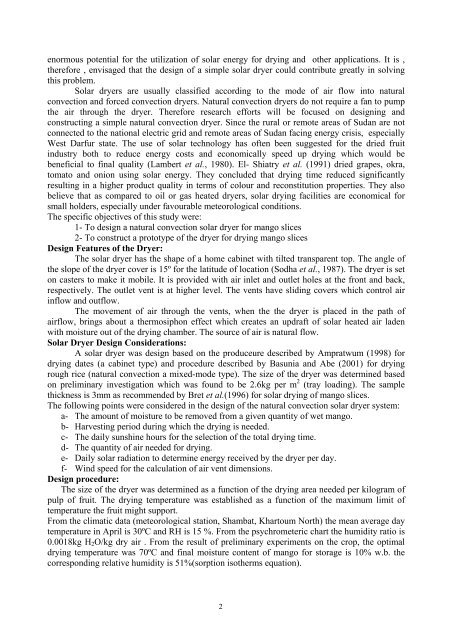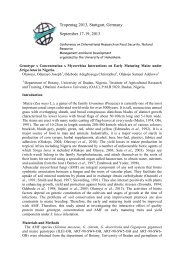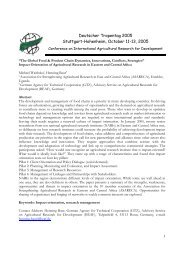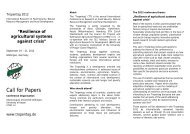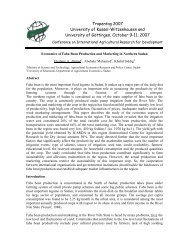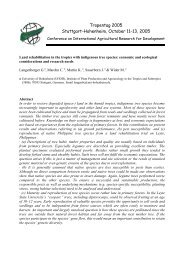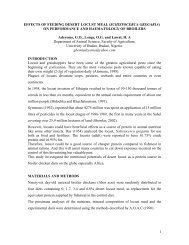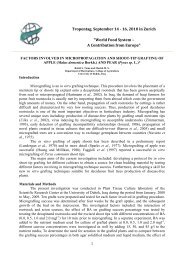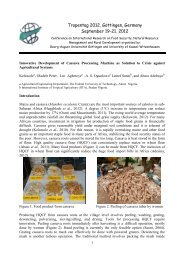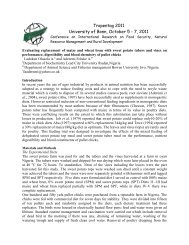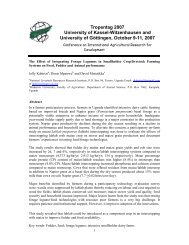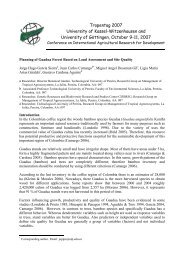Design and Construction of A Solar Dryer for Mango ... - Tropentag
Design and Construction of A Solar Dryer for Mango ... - Tropentag
Design and Construction of A Solar Dryer for Mango ... - Tropentag
You also want an ePaper? Increase the reach of your titles
YUMPU automatically turns print PDFs into web optimized ePapers that Google loves.
enormous potential <strong>for</strong> the utilization <strong>of</strong> solar energy <strong>for</strong> drying <strong>and</strong> other applications. It is ,<br />
there<strong>for</strong>e , envisaged that the design <strong>of</strong> a simple solar dryer could contribute greatly in solving<br />
this problem.<br />
<strong>Solar</strong> dryers are usually classified according to the mode <strong>of</strong> air flow into natural<br />
convection <strong>and</strong> <strong>for</strong>ced convection dryers. Natural convection dryers do not require a fan to pump<br />
the air through the dryer. There<strong>for</strong>e research ef<strong>for</strong>ts will be focused on designing <strong>and</strong><br />
constructing a simple natural convection dryer. Since the rural or remote areas <strong>of</strong> Sudan are not<br />
connected to the national electric grid <strong>and</strong> remote areas <strong>of</strong> Sudan facing energy crisis, especially<br />
West Darfur state. The use <strong>of</strong> solar technology has <strong>of</strong>ten been suggested <strong>for</strong> the dried fruit<br />
industry both to reduce energy costs <strong>and</strong> economically speed up drying which would be<br />
beneficial to final quality (Lambert et al., 1980). El- Shiatry et al. (1991) dried grapes, okra,<br />
tomato <strong>and</strong> onion using solar energy. They concluded that drying time reduced significantly<br />
resulting in a higher product quality in terms <strong>of</strong> colour <strong>and</strong> reconstitution properties. They also<br />
believe that as compared to oil or gas heated dryers, solar drying facilities are economical <strong>for</strong><br />
small holders, especially under favourable meteorological conditions.<br />
The specific objectives <strong>of</strong> this study were:<br />
1- To design a natural convection solar dryer <strong>for</strong> mango slices<br />
2- To construct a prototype <strong>of</strong> the dryer <strong>for</strong> drying mango slices<br />
<strong>Design</strong> Features <strong>of</strong> the <strong>Dryer</strong>:<br />
The solar dryer has the shape <strong>of</strong> a home cabinet with tilted transparent top. The angle <strong>of</strong><br />
the slope <strong>of</strong> the dryer cover is 15º <strong>for</strong> the latitude <strong>of</strong> location (Sodha et al., 1987). The dryer is set<br />
on casters to make it mobile. It is provided with air inlet <strong>and</strong> outlet holes at the front <strong>and</strong> back,<br />
respectively. The outlet vent is at higher level. The vents have sliding covers which control air<br />
inflow <strong>and</strong> outflow.<br />
The movement <strong>of</strong> air through the vents, when the the dryer is placed in the path <strong>of</strong><br />
airflow, brings about a thermosiphon effect which creates an updraft <strong>of</strong> solar heated air laden<br />
with moisture out <strong>of</strong> the drying chamber. The source <strong>of</strong> air is natural flow.<br />
<strong>Solar</strong> <strong>Dryer</strong> <strong>Design</strong> Considerations:<br />
A solar dryer was design based on the produceure described by Ampratwum (1998) <strong>for</strong><br />
drying dates (a cabinet type) <strong>and</strong> procedure described by Basunia <strong>and</strong> Abe (2001) <strong>for</strong> drying<br />
rough rice (natural convection a mixed-mode type). The size <strong>of</strong> the dryer was determined based<br />
on preliminary investigation which was found to be 2.6kg per m 2 (tray loading). The sample<br />
thickness is 3mm as recommended by Bret et al.(1996) <strong>for</strong> solar drying <strong>of</strong> mango slices.<br />
The following points were considered in the design <strong>of</strong> the natural convection solar dryer system:<br />
a- The amount <strong>of</strong> moisture to be removed from a given quantity <strong>of</strong> wet mango.<br />
b- Harvesting period during which the drying is needed.<br />
c- The daily sunshine hours <strong>for</strong> the selection <strong>of</strong> the total drying time.<br />
d- The quantity <strong>of</strong> air needed <strong>for</strong> drying.<br />
e- Daily solar radiation to determine energy received by the dryer per day.<br />
f- Wind speed <strong>for</strong> the calculation <strong>of</strong> air vent dimensions.<br />
<strong>Design</strong> procedure:<br />
The size <strong>of</strong> the dryer was determined as a function <strong>of</strong> the drying area needed per kilogram <strong>of</strong><br />
pulp <strong>of</strong> fruit. The drying temperature was established as a function <strong>of</strong> the maximum limit <strong>of</strong><br />
temperature the fruit might support.<br />
From the climatic data (meteorological station, Shambat, Khartoum North) the mean average day<br />
temperature in April is 30ºC <strong>and</strong> RH is 15 %. From the psychrometeric chart the humidity ratio is<br />
0.0018kg H2O/kg dry air . From the result <strong>of</strong> preliminary experiments on the crop, the optimal<br />
drying temperature was 70ºC <strong>and</strong> final moisture content <strong>of</strong> mango <strong>for</strong> storage is 10% w.b. the<br />
corresponding relative humidity is 51%(sorption isotherms equation).<br />
2


